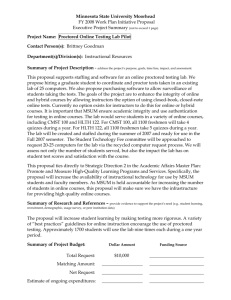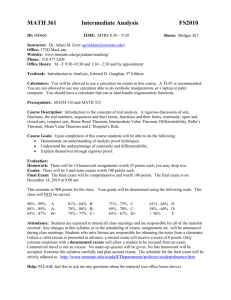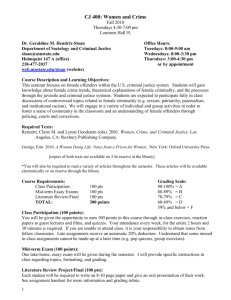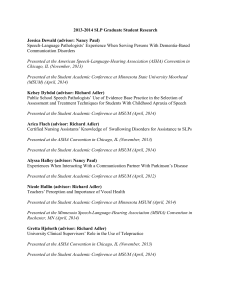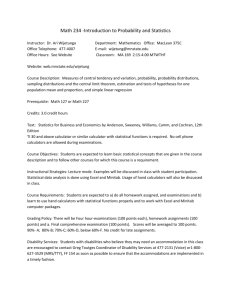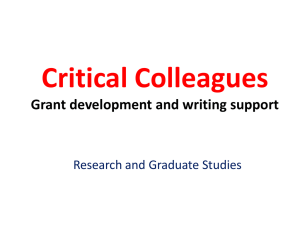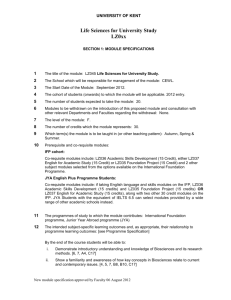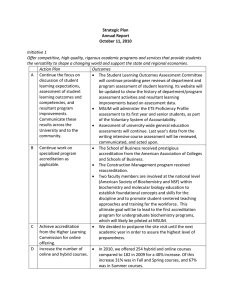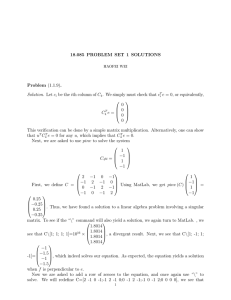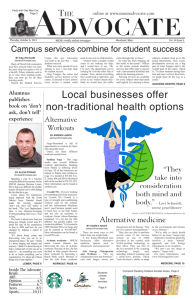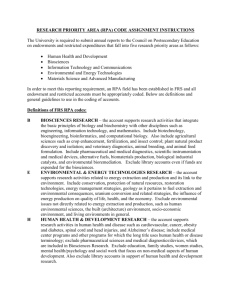Syllabus Senior Seminar BIOL 484 Spring 2010
advertisement
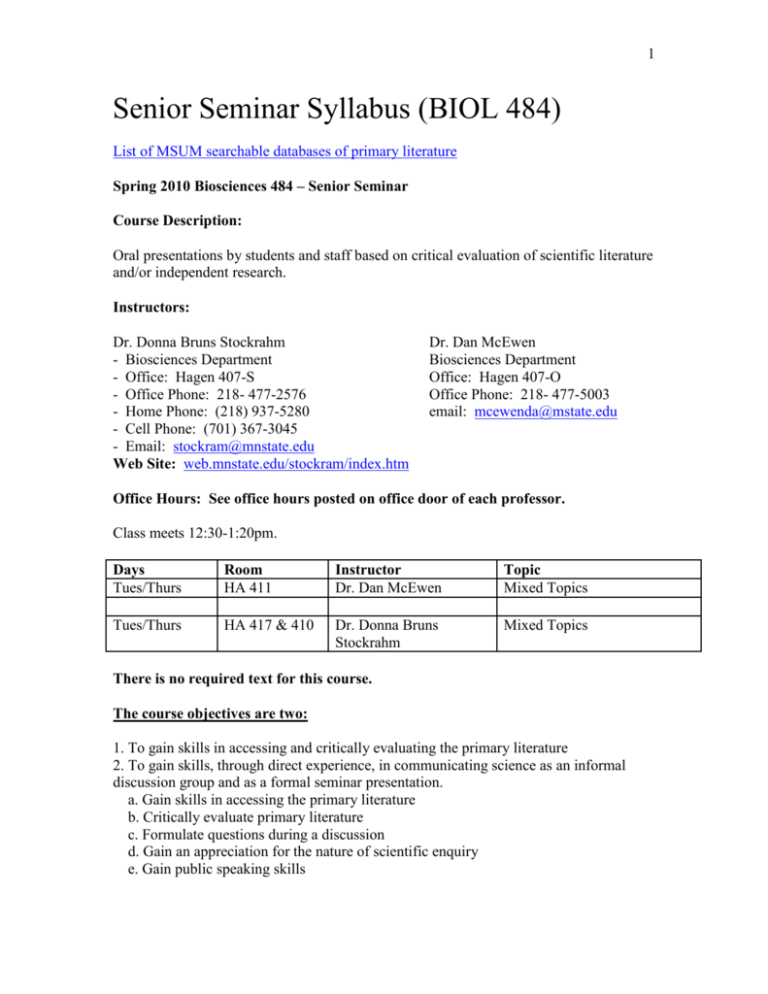
1 Senior Seminar Syllabus (BIOL 484) List of MSUM searchable databases of primary literature Spring 2010 Biosciences 484 – Senior Seminar Course Description: Oral presentations by students and staff based on critical evaluation of scientific literature and/or independent research. Instructors: Dr. Donna Bruns Stockrahm - Biosciences Department - Office: Hagen 407-S - Office Phone: 218- 477-2576 - Home Phone: (218) 937-5280 - Cell Phone: (701) 367-3045 - Email: stockram@mnstate.edu Web Site: web.mnstate.edu/stockram/index.htm Dr. Dan McEwen Biosciences Department Office: Hagen 407-O Office Phone: 218- 477-5003 email: mcewenda@mstate.edu Office Hours: See office hours posted on office door of each professor. Class meets 12:30-1:20pm. Days Tues/Thurs Room HA 411 Instructor Dr. Dan McEwen Topic Mixed Topics Tues/Thurs HA 417 & 410 Dr. Donna Bruns Stockrahm Mixed Topics There is no required text for this course. The course objectives are two: 1. To gain skills in accessing and critically evaluating the primary literature 2. To gain skills, through direct experience, in communicating science as an informal discussion group and as a formal seminar presentation. a. Gain skills in accessing the primary literature b. Critically evaluate primary literature c. Formulate questions during a discussion d. Gain an appreciation for the nature of scientific enquiry e. Gain public speaking skills 2 Expectations: 1. Attend class. Giving a presentation is a learning experience and a valuable skill that will help you in whatever career your future holds for you. Equally valuable is the ability to listen critically, to evaluate a presentation and formulate and ask probing questions. This is critical thinking – another hugely valuable skill that applies to any career path. Much of what this course offers is acquired as an audience member. Therefore, attendance is mandatory and part of the calculus of the “Pass” grade. Two unexcused absences will be tolerated. After that, the grade is an automatic fail. 2. Participate in discussions as animatedly as your personality and the law will allow. 3. Lead a paper discussion of a paper in the primary literature. 4. Present a “major” presentation – a synthesis of 4 or 5 related papers from the primary literature, and prepare a written abstract to be distributed at your talk. 5. Provide constructive feedback to the speaker of major presentations. Grading rubric: There are 100 points. A total of 60 points is needed to pass the course. Attendance is mandatory and not part of the point system 15 points = Participation in class. Each person should contribute to the discussion each day. The proportion of days for which each person takes part in conversation (asks a question, weighs in with a comment, etc) will be the proportion of 15 points earned for participation. 15 points = Submitting questions to D2L (or email mailing list, depending on which one is working best). Each student must submit 2 questions for each minor presentation. One question should relate to either the introduction or the methods of the paper being discussed. The second question should relate to the results or the discussion of the paper being discussed. Submit the questions at least 24 hours before the presentation so that the facilitator has a chance to read, research and prepare answers to the questions. The grade for questions will be assessed as the proportion of the number of questions that were submitted as a ratio of the number of questions that should have been submitted. 20 points = Minor presentation. Each student will lead a paper discussion of an assigned paper. These papers will be posted as pdf’s on Dr. Stockrahm's web page. 50 points = Major presentation. 30 points will be for the presentation itself, 20 points will be for the process of preparing for the presentation. Details on this rubric are forthcoming. 3 Guide to paper discussions: Read the article. Read it again, flag areas that still don’t seem clear. Ask a faculty from that specialty to clarify jargon, concepts. Sketch out the main skeleton of the article: o What was the main question? o How did they test it? o What did they find? o What does it mean? What is the larger significance of their findings? During the discussion, avoid re-reading the paper verbatim, or sections of it (except the occasional statement) because presumably everyone has read it. Instead, paraphrase the article using your own words, highlighting the main points and areas that you were particularly impressed by and areas that you thought didn’t make sense or were just plain wrong (from your perspective). Try to think of at least 2 questions you had about the study, either a fault in the logic of the arguments and reasoning, or a question about methodology that is not clearly described. Be aware that scientists write for other scientists and often assume a certain amount of background in the reader. Listen carefully. There are bound to be aspects of the paper that missed you on the first read, and people from different viewpoints read a manuscript differently and may have a different interpretation of the paper than you did. Major presentation: The major presentation is done by each individual in the course. You are required to work with a faculty member as you prepare your talk. You will not be allowed to present your talk unless your faculty advisor has signed off on it verifying that you have met with them during preparation of the talk and rehearsed the talk with your advisor. The talk is a 35-40 minute PowerPoint presentation on 4 or 5 related papers from the primary literature. These papers should be chosen carefully so that they link together to tell a larger story. The presentation should be organized as follows: 1. General introduction. An overview of the whole talk to introduce the audience to the phenomenon being presented. The major presentations are often attended by students from introductory biology (Cell, Organismal); therefore, you should be careful to explain terminology for a general audience. 2. Paper 1. Provide the title, authors, and source of the paper (journal, date, volume, pages). Then proceed to describe the specific question(s) addressed in this paper, the methods used, the results (include figures and tables as much as possible), and interpretation of the findings. 3. Paper 2. 4. Paper 3. 5. Paper 4. 4 6. Paper 5. 7. General conclusion. These are the wrap-up over-all conclusions of the whole presentation. The format of the talk can be summarized thusly: tell them what you’re going to say, say it, them tell them what you just told them. The conclusion is important because it allows you to highlight the main take-home message of your presentation. General advice for the major presentation: 1. Rehearse your talk with your advisor at least once and rehearse some more with friends/family so that you are comfortable and confident with the content and timing of your talk. 2. Avoid too much text. A common error is to write the talk in prose on the PowerPoint slides. Stick to bullet lists with minimal verbage. Better still, use no words on the slide and instead post an image and talk through the contents while the audience looks at a picture of what you are talking about. 3. Avoid busy background templates with swirling lines and dark and light areas. No color of text can contrast well with a background that varies from light to dark. 4. Generally, light text on a dark background is easier to see than dark text on a light background. 5. Dress neatly and comfortably. 6. Face the audience and make eye contact during the presentation. A common error is to spend much of the talk facing the screen. 7. Try to control repetitive body movement (rocking, fidgeting) and excessive “umms”. Academic honesty: All students are expected to be honest in all their work for this class. In the event of joint projects, all students working on the project are expected to contribute equally to the final product. See MSUM Student Handbook address: http://web.mnstate.edu/shandbook/POLICY/index.htm. Students with disabilities: Students with disabilities who believe they may need an accommodation in this class are encouraged to contact Greg Toutges, Coordinator of Disability Services at 477-5859 (voice) or 1-800-627-3529 (MRS/TTY), CMU 114 as soon as possible to ensure that accommodations are implemented in a timely fashion. Attendance policy: Students are expected to attend all seminars (see above). See MSUM Student Handbook address above. MSUM Home Page Stockrahm's Home Page Biosciences Home Page

